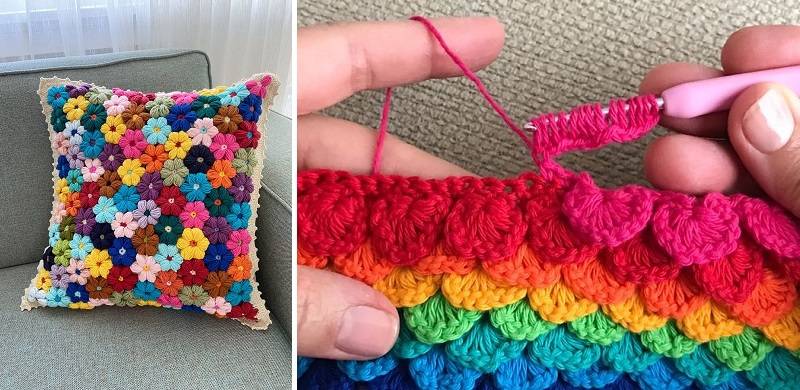
Crafts have always been a part of our past culture and civilisations. Despite the mechanised modernisation in all spheres of life, the importance of centuries-old arts and crafts cannot be ignored. About six to seven hundred years ago, when there was no concept of modern industry, factories and manufacturing houses, people were completely devoted to the art of weaving their garments, needlework and crocheting to survive and protect themselves from the changing seasons. Even in today's era of development, traditional handmade items are required to beautify and embellish various structures.
In making items like cushions, pillows, covers of dressing tables, beds and sofas, the traditional craft of crocheting has been known for centuries. Most of the rural women are very much engaged in the profession of crocheting various items like socks, sweaters, gloves, hats, covers, cushions and many other decorative items using yarn.
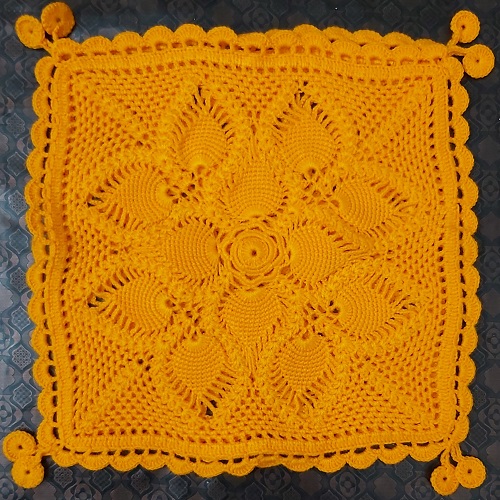 Crocheting is the process of joining together strands of yarn, thread and other materials to create a fabric using only the crochet hook. The name is derived from the French term crochet, meaning 'little hook.' These crochet hooks are mainly made of bamboo wood, metals and plastics.
Crocheting is the process of joining together strands of yarn, thread and other materials to create a fabric using only the crochet hook. The name is derived from the French term crochet, meaning 'little hook.' These crochet hooks are mainly made of bamboo wood, metals and plastics.
The art of crocheting originally developed from the traditional methods of Arabia, South America and China. However, there is no evidence of this craft before its popularity in Europe during the 1800s. In Scotland, the type of weaving done by the peasants with a small hook-needle took precedence over all other decorative works within a few years. Nevertheless, the art of crochet later attained its highest degree of perfection in England. Although crochet later declined in popularity, the early 21st century has seen a resurgence of interest in the craft, along with improvements in yarn quality and variety. After World War II, from the 1940s to the early 1960s, there was a great revival of handmade crafts in the subcontinent and many other parts of the world, with many new and imaginative designs of colourful dolls, pitchers, and other household items.
Among the countless Pakistani women who are well known for the art of crocheting, my mother Bilquis Bibi is full of skills and talent, doing her crocheting work at home. She belongs to Baddoki Gosaian, a small town of Gujranwala.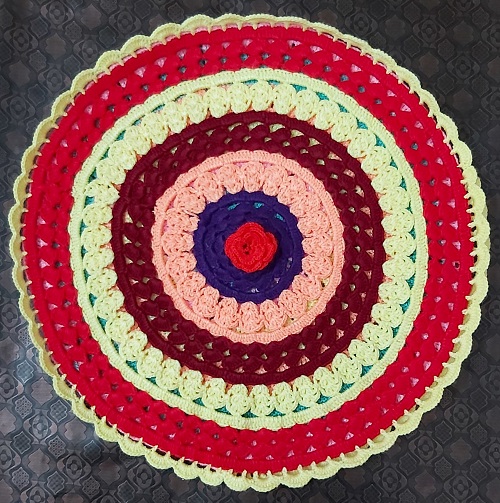
In my conversation with her, she tells me that she was only 16 when she had learned crocheting from her mother Kulsoom (deceased). "Kulsoom was also very adept at making a variety of objects using yarn," says Bilquis. Metaphorically, Bilquis is the perfect reflection of her late mother, Kulsoom, in the historic art of crochet.
Bilquis says, "I have been crocheting for almost 25 years because of my deep passion for art works. Apart from crocheting, I also like to do different kinds of embroidery work. However, my specialty is only in crocheting. Bilquis says that she has never crocheted for monetary gains as she only crochets for the love of artwork.
Bilquis is highly skilled in crafting and crocheting variety of items like covers of pillows and cushions, men and women sweaters, socks, beautiful covers for mirrors and dressing tables, covers for fans laced with stunning embroidery, beautiful covers for copies of the Holy Quran, covers for baby feeders, trey covers, glass covers, various covers for dining table utensils, crochet work on women’s shawls, beautiful crochet work on bed sheets and a lot more.
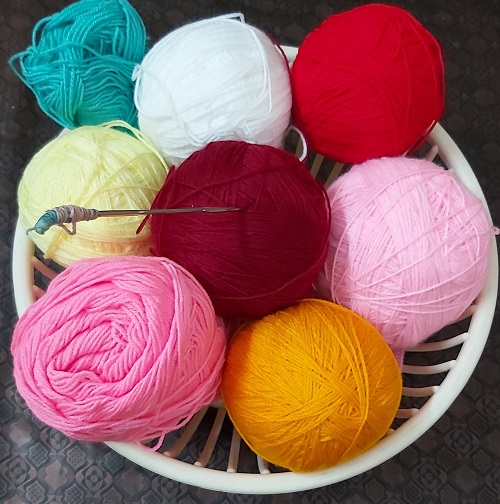 "The unique thing about my work," she says, "is that I don't copy things created by other people on the internet or in the field of crocheting. I mostly prefer to create my own designs according to the changing trends." Another quality of my work is the use of neat and different coloured threads in appropriate patterns which makes my crocheting work wonderful.”
"The unique thing about my work," she says, "is that I don't copy things created by other people on the internet or in the field of crocheting. I mostly prefer to create my own designs according to the changing trends." Another quality of my work is the use of neat and different coloured threads in appropriate patterns which makes my crocheting work wonderful.”
Bilquis says that there are essentially six main types of crochet stitches that she has mastered. They are as follows:
1: Chain stitch – the most basic of all stitches and used in almost all types of crocheting
2: Slip stitch – this is used to join the chain stitch to make a ring
3: Single Crochet – the easiest stitch to master
4: Half Double Crochet Stitch – this is the middle stitch
5: Double Crochet Stitch – this is widely used as a bar yarn
6: Tribal Crochet Stitch – this is used twice as yarn
Bilquis says, "The thing of greatest joy for me is that I have trained and skilled more than twenty girls in the field of crochet. I have thoroughly trained them, tutored them, and helped them out of my heart to learn all the trending and the most complex designs of crocheting at my home. I have never ever charged even a penny from my pupils in return for my magnanimous services is really something that provides me with inner peace and contentment."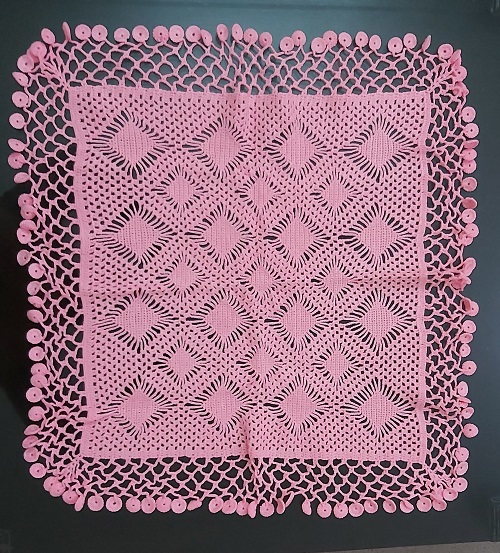
"There can be no greater joy and satisfaction than seeing one's art promoted by one's disciples," Bilquis adds. Bilquis proudly says that currently a large number of my female students including Shamsa Aslam, Kiran Raffakat, Saima from Nowshera Warkan, Shazia Khalil, Iqra Arif and many others are earning their bread in this field of crocheting. A few of my students have even hired other girls to handle the workload. Some of them are also working on a large scale. They get huge orders from the elite clients living in the Cantonment and other posh areas.
Furthermore, she tells me that machine-made items in various industries could not compete with indigenously made handicrafts at home. She believes that handicrafts made in vernacular styles are always durable, unlike machine-made items. Colour patterns, designs and use of yarn in crocheting always reflect the unique culture of our ancestors.
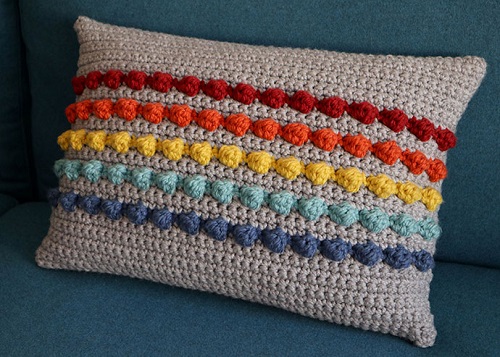 However, my mother is very concerned over the shifting of handicrafts to machines on a large scale. She laments that the transfer of hand-made handicrafts to factories would diminish its importance and push us away from our ancient culture of arts and crafts. Currently, barely 10% of women in Pakistan are involved in the crocheting profession. And this percentage is decreasing with every passing year. Bilquis adds, "I fear that this downward trend will result in massive unemployment in my country and cause loss to many families who have made crocheting their livelihood and will be deprived of it."
However, my mother is very concerned over the shifting of handicrafts to machines on a large scale. She laments that the transfer of hand-made handicrafts to factories would diminish its importance and push us away from our ancient culture of arts and crafts. Currently, barely 10% of women in Pakistan are involved in the crocheting profession. And this percentage is decreasing with every passing year. Bilquis adds, "I fear that this downward trend will result in massive unemployment in my country and cause loss to many families who have made crocheting their livelihood and will be deprived of it."
She emphasises that correct and timely steps should be taken at the national level to save our weaving and crocheting tradition. In her view, its maximum countrywide promotion through print and electronic media could go a long way in keeping this dying art of crocheting alive.
Finally, my mother also thanked me for listening to her carefully to pen down her thoughts about this rich art.
In making items like cushions, pillows, covers of dressing tables, beds and sofas, the traditional craft of crocheting has been known for centuries. Most of the rural women are very much engaged in the profession of crocheting various items like socks, sweaters, gloves, hats, covers, cushions and many other decorative items using yarn.
 Crocheting is the process of joining together strands of yarn, thread and other materials to create a fabric using only the crochet hook. The name is derived from the French term crochet, meaning 'little hook.' These crochet hooks are mainly made of bamboo wood, metals and plastics.
Crocheting is the process of joining together strands of yarn, thread and other materials to create a fabric using only the crochet hook. The name is derived from the French term crochet, meaning 'little hook.' These crochet hooks are mainly made of bamboo wood, metals and plastics.The art of crocheting originally developed from the traditional methods of Arabia, South America and China. However, there is no evidence of this craft before its popularity in Europe during the 1800s. In Scotland, the type of weaving done by the peasants with a small hook-needle took precedence over all other decorative works within a few years. Nevertheless, the art of crochet later attained its highest degree of perfection in England. Although crochet later declined in popularity, the early 21st century has seen a resurgence of interest in the craft, along with improvements in yarn quality and variety. After World War II, from the 1940s to the early 1960s, there was a great revival of handmade crafts in the subcontinent and many other parts of the world, with many new and imaginative designs of colourful dolls, pitchers, and other household items.
Among the countless Pakistani women who are well known for the art of crocheting, my mother Bilquis Bibi is full of skills and talent, doing her crocheting work at home. She belongs to Baddoki Gosaian, a small town of Gujranwala.

In my conversation with her, she tells me that she was only 16 when she had learned crocheting from her mother Kulsoom (deceased). "Kulsoom was also very adept at making a variety of objects using yarn," says Bilquis. Metaphorically, Bilquis is the perfect reflection of her late mother, Kulsoom, in the historic art of crochet.
Bilquis says, "I have been crocheting for almost 25 years because of my deep passion for art works. Apart from crocheting, I also like to do different kinds of embroidery work. However, my specialty is only in crocheting. Bilquis says that she has never crocheted for monetary gains as she only crochets for the love of artwork.
Bilquis is highly skilled in crafting and crocheting variety of items like covers of pillows and cushions, men and women sweaters, socks, beautiful covers for mirrors and dressing tables, covers for fans laced with stunning embroidery, beautiful covers for copies of the Holy Quran, covers for baby feeders, trey covers, glass covers, various covers for dining table utensils, crochet work on women’s shawls, beautiful crochet work on bed sheets and a lot more.
 "The unique thing about my work," she says, "is that I don't copy things created by other people on the internet or in the field of crocheting. I mostly prefer to create my own designs according to the changing trends." Another quality of my work is the use of neat and different coloured threads in appropriate patterns which makes my crocheting work wonderful.”
"The unique thing about my work," she says, "is that I don't copy things created by other people on the internet or in the field of crocheting. I mostly prefer to create my own designs according to the changing trends." Another quality of my work is the use of neat and different coloured threads in appropriate patterns which makes my crocheting work wonderful.”Bilquis says that there are essentially six main types of crochet stitches that she has mastered. They are as follows:
1: Chain stitch – the most basic of all stitches and used in almost all types of crocheting
2: Slip stitch – this is used to join the chain stitch to make a ring
3: Single Crochet – the easiest stitch to master
4: Half Double Crochet Stitch – this is the middle stitch
5: Double Crochet Stitch – this is widely used as a bar yarn
6: Tribal Crochet Stitch – this is used twice as yarn
Bilquis says, "The thing of greatest joy for me is that I have trained and skilled more than twenty girls in the field of crochet. I have thoroughly trained them, tutored them, and helped them out of my heart to learn all the trending and the most complex designs of crocheting at my home. I have never ever charged even a penny from my pupils in return for my magnanimous services is really something that provides me with inner peace and contentment."

"There can be no greater joy and satisfaction than seeing one's art promoted by one's disciples," Bilquis adds. Bilquis proudly says that currently a large number of my female students including Shamsa Aslam, Kiran Raffakat, Saima from Nowshera Warkan, Shazia Khalil, Iqra Arif and many others are earning their bread in this field of crocheting. A few of my students have even hired other girls to handle the workload. Some of them are also working on a large scale. They get huge orders from the elite clients living in the Cantonment and other posh areas.
Furthermore, she tells me that machine-made items in various industries could not compete with indigenously made handicrafts at home. She believes that handicrafts made in vernacular styles are always durable, unlike machine-made items. Colour patterns, designs and use of yarn in crocheting always reflect the unique culture of our ancestors.
 However, my mother is very concerned over the shifting of handicrafts to machines on a large scale. She laments that the transfer of hand-made handicrafts to factories would diminish its importance and push us away from our ancient culture of arts and crafts. Currently, barely 10% of women in Pakistan are involved in the crocheting profession. And this percentage is decreasing with every passing year. Bilquis adds, "I fear that this downward trend will result in massive unemployment in my country and cause loss to many families who have made crocheting their livelihood and will be deprived of it."
However, my mother is very concerned over the shifting of handicrafts to machines on a large scale. She laments that the transfer of hand-made handicrafts to factories would diminish its importance and push us away from our ancient culture of arts and crafts. Currently, barely 10% of women in Pakistan are involved in the crocheting profession. And this percentage is decreasing with every passing year. Bilquis adds, "I fear that this downward trend will result in massive unemployment in my country and cause loss to many families who have made crocheting their livelihood and will be deprived of it."She emphasises that correct and timely steps should be taken at the national level to save our weaving and crocheting tradition. In her view, its maximum countrywide promotion through print and electronic media could go a long way in keeping this dying art of crocheting alive.
Finally, my mother also thanked me for listening to her carefully to pen down her thoughts about this rich art.

